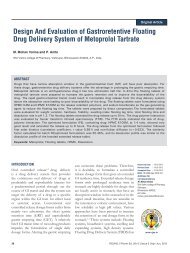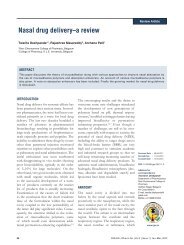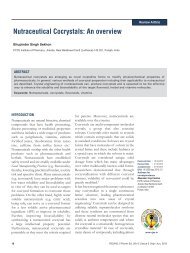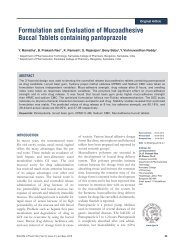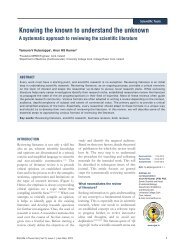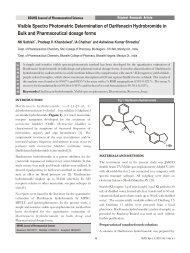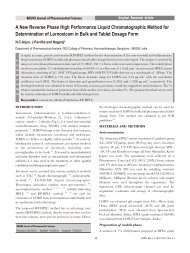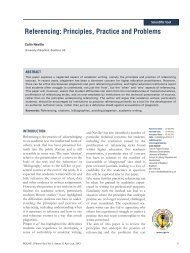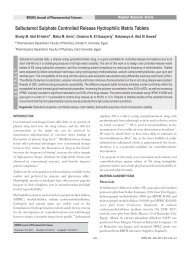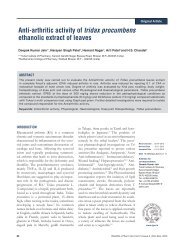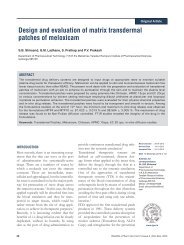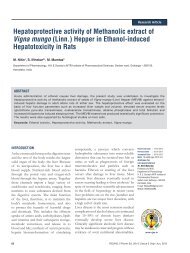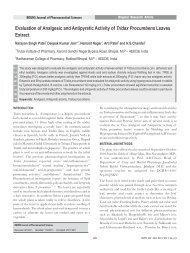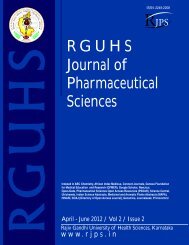Chitosan Loaded Mucoadhesive Microspheres of Gliclazide - Journal
Chitosan Loaded Mucoadhesive Microspheres of Gliclazide - Journal
Chitosan Loaded Mucoadhesive Microspheres of Gliclazide - Journal
You also want an ePaper? Increase the reach of your titles
YUMPU automatically turns print PDFs into web optimized ePapers that Google loves.
period <strong>of</strong> 6-8 h. After the reaction, the reaction mixture was<br />
extracted with toluene and poured in to 150 ml <strong>of</strong> water and<br />
made basic to pH-9. The aqueous and toluene layers were<br />
separated. Toluene was distilled out to form a semisolid<br />
product. Acetone was added and made acidic to pH-2 by the<br />
addition <strong>of</strong> acid to obtain the final product.<br />
-1<br />
IR (KBR) cm :3068(ArC-H str), 2951(aliph C-Hstr),<br />
1629(C=C, str), 1469(C-S-C str), 1081(C-N str) (Compound<br />
GKRA-13).<br />
1<br />
HNMR (TMS) δ: 6.96-7.33{m, 8H,Ar-H};5.90 {t,1H,<br />
Unsat. C=CH-E-isomer};5.83{t,1H, Unsat. C=CH-Zi<br />
s o m e r } ; 4 . 7 8 - 4 . 8 5 { t , 2 H , N C H 2 } ; 3 . 3 8 - 3 . 4 5<br />
{t,1H,CH 2};3.08{m, 2H, CH2-S-C }; 2.53-2.70 {s, 6H, 2 х<br />
CH 3 }[Compound GKRA-13 obtained from p-Toluyl<br />
sulphonic acid] (Fig. 1).<br />
Compounds GKRA-07 to GKRA-12 were obtained in the<br />
similar manner by using various acids (Table 1).<br />
Determination <strong>of</strong> percentage <strong>of</strong> (E- and Z-) N,Ndimethyl-3-<br />
(dibenzo[b,e]thiepin-11(6H)ylidene)<br />
propylamine hydrochloride by High performance<br />
liquid chromatography<br />
Test solution: Dissolved 0.02 g <strong>of</strong> the N,N-dimethyl-3-<br />
(dibenzo[b,e]thiepin-11(6H)ylidene) propylamine<br />
hydrochloride in the mobile phase and dilute to 20 ml with the<br />
mobile phase. 1 ml <strong>of</strong> this solution was diluted to 10 ml with<br />
the mobile phase.<br />
Chromatographic Procedure<br />
Separation was carried out on Wakosil II (SGE) C-18<br />
column, length 10cm and internal diameter 0.5 cm, particle<br />
o<br />
size 5µ. Column oven was set at 50 C and detection was<br />
carried out at 254 nm. Mobile phase comprised <strong>of</strong> a mixture<br />
1<br />
Fig 1: H-NMR spectrum <strong>of</strong> GKRA-13<br />
Gopal Krishna Rao et al./ Effect <strong>of</strong> Different Acids on the Formation <strong>of</strong> E and Z Isomers <strong>of</strong> Dothiepin<br />
1<br />
HNMR (TMS) δ: 6.96-7.33{m, 8H,Ar-H};5.90 {t,1H, Unsat.<br />
C=CH-E-isomer};5.83 {t,1H, Unsat. C=CH-Z-isomer};4.78-<br />
4.85{t,2H,NCH 2};3.38-3.45 {t,1H,CH 2};3.08{m, 2H, CH2-S-C };<br />
2.53-2.70 {s, 6H, 2 х CH 3 }[Compound GKRA-13 obtained from<br />
p-Toluyl sulphonic acid] Scheme - 1<br />
173<br />
<strong>of</strong> 30 volumes <strong>of</strong> methanol and 70 volumes <strong>of</strong> a 30 g/l<br />
solution <strong>of</strong> sodium dihydrogen phosphate, previously<br />
adjusted to pH 2.5 with phosphoric acid.<br />
Procedure<br />
20 µl <strong>of</strong> the test solution was injected. The system sensitivity<br />
was adjusted so that the height <strong>of</strong> the principal peak is at least<br />
50 % <strong>of</strong> the full scale <strong>of</strong> the recorder. The test is not valid<br />
unless the resolution between the first peak (E-isomer) and the<br />
second peak (Z-isomer) is at least 1.5 (Fig. 2).<br />
The percentages <strong>of</strong> both the isomers formed are tabulated in<br />
(Table 2).<br />
RESULT AND DISCUSSION<br />
The percentage <strong>of</strong> E-isomer is found to be higher than Zisomer<br />
in all the experiments. The conversion <strong>of</strong> (11RS)-11-<br />
[3-(dimethylamino) propyl]-6,11-dihydrodibenzo[b,e]<br />
thiepin-11-ol (Compound A) to E- & Z- N,N-dimethyl-3-<br />
(dibenzo[b,e]oxepin-11(6H) ylidene) propylamine<br />
(Compounds 1 and 2) was complete as shown by IR spectra<br />
-1<br />
with appearance <strong>of</strong> C=CH peak at 1602 cm .<br />
SCHEME 1<br />
E-isomer<br />
1<br />
CH 3<br />
S<br />
OH<br />
(A)<br />
N<br />
CH 3<br />
CH 3<br />
Acid catalyst<br />
toluene<br />
S S<br />
N<br />
CH3 H3C H3C N<br />
Z-isomer<br />
2<br />
RJPS, Jul - Sep, 2011/ Vol 1/ Issue 2



